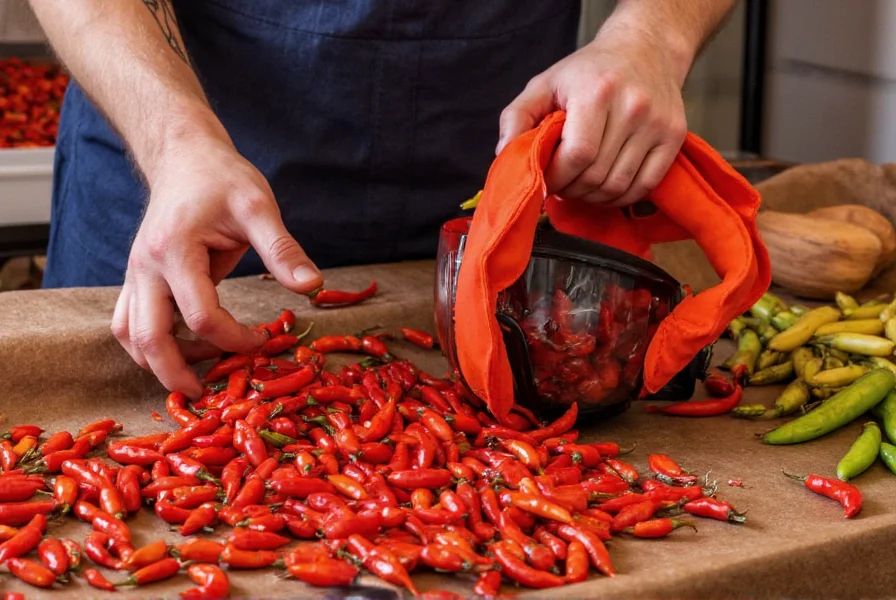When comparing the Carolina Reaper vs Ghost Chili, understanding their heat levels, flavor profiles, and practical applications is essential for both culinary enthusiasts and pepper aficionados. These two superhot peppers dominate the upper echelons of the Scoville scale, but they offer distinct characteristics that affect how they're grown, handled, and used in cooking.
Origins and Development
The Ghost Chili, also known as Bhut Jolokia, originated in the northeastern regions of India. For years, it held the title of world's hottest chili until 2011. Indian military researchers discovered its extreme heat could be weaponized for non-lethal applications like smoke grenades.
In contrast, the Carolina Reaper was deliberately bred by South Carolina grower Ed Currie through cross-pollination of a Pakistani Naga pepper and a Red Habanero. Currie's goal was to create a pepper with both extreme heat and distinctive flavor. The Carolina Reaper officially claimed the Guinness World Record in 2013 and maintained this title until 2023 when it was surpassed by the Pepper X.
Heat Comparison: Scoville Scale Analysis
| Pepper Variety | Scoville Heat Units (SHU) | Guinness World Record Status | Heat Relative to Habanero |
|---|---|---|---|
| Carolina Reaper | 1,400,000-2,200,000 SHU | 2013-2023 | 2-3 times hotter |
| Ghost Chili (Bhut Jolokia) | 855,000-1,041,427 SHU | 2007-2011 | 2 times hotter |
The Scoville scale measurements reveal why the Carolina Reaper consistently tests hotter than the Ghost Chili. While Ghost Peppers typically measure around 1 million SHU, Carolina Reapers frequently exceed 1.5 million SHU, with some specimens reaching the 2 million mark. This substantial difference means that substituting one for the other in recipes requires careful consideration of heat tolerance.
Flavor Profiles and Culinary Applications
Beyond raw heat, these peppers offer distinctive flavor experiences that affect their culinary uses. The Ghost Chili delivers an initial fruity sweetness followed by intense, almost immediate heat that builds rapidly. Its flavor profile contains subtle smoky notes with hints of apple and citrus.
The Carolina Reaper, despite its extreme heat, offers a more complex flavor journey. It begins with a sweet, fruity aroma reminiscent of cherries or apples, followed by a delayed but overwhelming heat wave. This delayed reaction can catch inexperienced eaters off guard, as the full heat impact doesn't register for 30-45 seconds after consumption.
Chefs working with these superhots should understand that carolina reaper vs ghost pepper flavor profile differences significantly impact recipe development. The Reaper's sweeter initial notes make it slightly more versatile in sauces and preserves, while the Ghost Chili's immediate heat works better in dishes where quick heat infusion is desired.
Physical Characteristics and Identification
Visually distinguishing between these peppers helps prevent accidental extreme heat exposure. The Ghost Chili typically grows to 2.5-3.5 inches long with a bumpy, wrinkled texture and vibrant red, orange, or yellow coloration when mature.
The Carolina Reaper features a distinctive stinger-like tail and irregularly shaped body, usually growing to 1-2 inches in length. Its color ranges from bright red to orange when fully ripe, with a characteristic bumpy, gnarled appearance. This unique shape makes the carolina reaper vs ghost pepper appearance comparison relatively straightforward for experienced growers.

Growing Requirements and Yield
For home gardeners considering which superhot to cultivate, understanding their growing requirements is crucial. Ghost Chilies thrive in hot, humid climates similar to their native Northeast India. They typically mature in 90-120 days and produce abundant yields of 25-30 peppers per plant under optimal conditions.
Carolina Reapers require similar growing conditions but tend to be slightly more challenging to cultivate. They need 90-100 days to mature but often produce fewer peppers per plant (15-25). The ghost chili growing conditions versus Carolina Reaper requirements show that Reapers benefit from slightly more consistent moisture and may be more susceptible to certain fungal diseases.
Safety Considerations When Handling Superhots
Working with either of these peppers demands serious safety precautions. The capsaicin concentration in both can cause severe skin irritation, eye damage, and respiratory issues. Always wear nitrile gloves (latex won't protect against capsaicin) and eye protection when handling, cutting, or processing these peppers.
Never touch your face while handling superhots, and thoroughly clean all surfaces and tools afterward. If using in cooking, start with minuscule amounts—can you substitute ghost pepper for carolina reaper requires careful adjustment as the heat difference is substantial. A single Carolina Reaper seed contains enough capsaicin to overwhelm most palates.

Practical Usage Recommendations
For culinary applications, understanding the carolina reaper vs ghost pepper heat comparison helps determine appropriate usage. Ghost Peppers work well in traditional hot sauces, vindaloo curries, and as a primary heat source in moderately spicy dishes. Their immediate heat delivery makes them predictable for experienced cooks.
Carolina Reapers shine in specialty hot sauces, infused oils, and extremely spicy condiments where their delayed heat and complex flavor can be properly managed. Due to their extreme heat, they're often used in minute quantities—sometimes just a few seeds per batch of sauce.
For those attempting the infamous hot pepper challenges, understanding the which is hotter carolina reaper or ghost chili question could prevent unnecessary discomfort. The Carolina Reaper's delayed heat reaction combined with its higher Scoville rating makes it significantly more challenging to consume than the Ghost Chili.
Conclusion: Choosing Between These Superhot Peppers
When deciding between Carolina Reaper and Ghost Chili for your culinary or gardening needs, consider your heat tolerance, intended use, and growing capabilities. The Ghost Chili remains an excellent choice for those seeking extreme heat with slightly more manageable intensity and better yield. The Carolina Reaper delivers unparalleled heat for those seeking the ultimate challenge, but requires greater caution in handling and usage.
Regardless of which pepper you choose, always respect their power, use proper safety measures, and remember that the carolina reaper scoville units vs ghost pepper difference represents a substantial jump in heat intensity that should inform all usage decisions.










 浙公网安备
33010002000092号
浙公网安备
33010002000092号 浙B2-20120091-4
浙B2-20120091-4